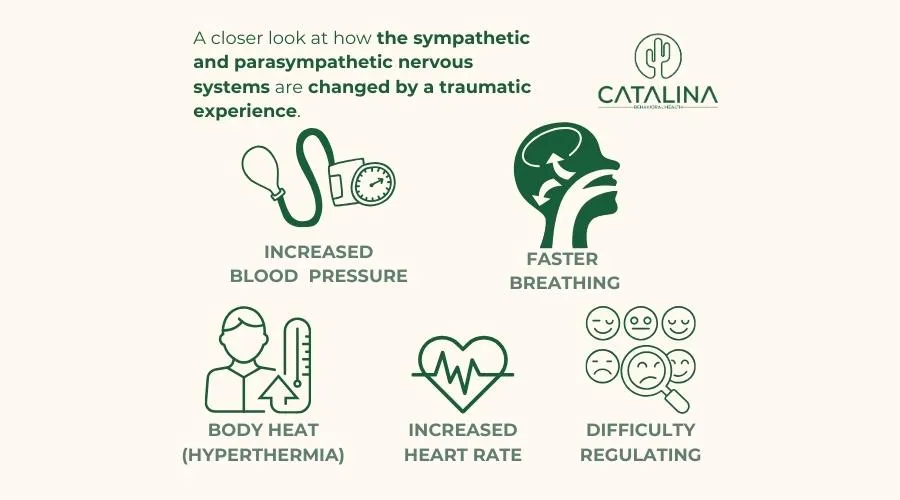Using EMDR to Support Complex PTSD Recovery
EMDR therapy is one of the leading treatments for complex trauma. Catalina Behavioral Health is passionate about using evidence-based treatments like EMDR and other therapies to help clients overcome traumatic experiences and get to where they want to be.
If you have heard of EMDR and are struggling with trauma, you might wonder what to expect, including how long does EMDR take for Complex Trauma. This page will help you gain a full understanding of what to expect in EMDR and compelling reasons to seek our assistance at Catalina.
First, let’s talk about complex post-traumatic stress disorder. Then, we will discuss how EMDR can help and everything you should know about the process.
Get Complex Trauma Treatment Options Now!
About Trauma and Complex Post-Traumatic Stress Disorders

People with complex trauma may meet the criteria for a condition called complex post-traumatic stress disorder, a complex form of PTSD. Often referred to as complex PTSD or C-PTSD, complex post-traumatic stress disorder can come with all of the same symptoms as PTSD. However, it usually comes with additional or more severe symptoms.
Alongside increased severity of symptoms, the main difference between PTSD and complex PTSD is that complex PTSD occurs in those who have experienced repeated trauma, multiple traumas, or prolonged traumatic events rather than single-incident trauma or short-term traumatic event, like a car accident.
Examples of events that may lead to the need for complex PTSD inpatient treatment include but aren’t limited to ongoing childhood trauma (e.g., continued physical, emotional, or sexual abuse in childhood, including emotional neglect), war, an abusive relationship, or prolonged domestic violence. EMDR is a well-known kind of therapy used in trauma treatment with a high efficacy rate.
The Role of EMDR Therapy in Trauma Treatment

EMDR stands for “eye movement desensitization and reprocessing.” EMDR therapy is a treatment designed to desensitize you from traumatic memories, trauma triggers, and negative cognitions associated with or stemming from traumatic events.
It often entails following a therapist’s hand movements with your eyes, but some therapists use auditory or tactile bilateral stimulation instead. In the initial stages, you will get comfortable with your therapist and develop trust. After that, you will move into the bulk of treatment.
The 8 Phases of EMDR Following a Traumatic Event
EMDR therapy employs eight phases. The following eight phases will occur in order as you work with an EMDR therapist:
- History and planning: In the history-taking and planning phase, an EMDR therapist asks about a client’s life experiences and the symptoms they experience in the present moment. During this stage, you’ll tell your therapist about the traumatic event(s) you have experienced and how they affect you at this time.
- Preparation: The preparation phase focuses on helping clients fully understand what to expect during EMDR therapy. During this stage, you’ll learn what to do during an EMDR session, your potential physical and emotional reactions during treatment, and how to cope with distress during treatment.
- Assessment: The assessment phase focuses on identifying the traumatic memories a client wants to work through and rating their distress. During this stage, you’ll rate your reactions to trauma triggers and distressing memories using a numbered scale.
- Desensitization: The desensitization phase is where the bulk of EMDR treatment occurs. This is the stage where your therapist will instruct you to follow their hands with your eyes. Some therapists may use sounds or tapping instead.
- Installation: While continuing the process of bilateral stimulation depicted in the desensitization stage, the installation phase is designed to instill a positive belief or thought surrounding a traumatic memory. You’ll work with your therapist to “install” those positive beliefs or thoughts during this stage. The goal is that positive thoughts, emotions, and beliefs will replace automatic undesirable reactions you have experienced when met with triggers up until this point.
- Body scan: After completing the desensitization and installation stages, clients are instructed to engage in a body scan. This entails paying attention to the body sensations you experience. Your therapist will likely instruct you to focus on one area of your body at a time.
- Closure: At the end of each reprocessing session, you’ll engage in a stage called “closure.” The goal of this stage is to return you to a state of relaxation. During this stage, you should experience neutral feelings about the event, positive beliefs, and a lack of bodily disturbance.
- Reevaluation of treatment: The reevaluation phase is exactly what it sounds like. During this stage, you will rate your level of distress just like you did in the assessment stage. However, your stress response to the memory should have decreased, and the number should be lower. Then, you and your therapist will reevaluate your treatment and talk about what the next session will look like, with the goal of continuing to lower your distress until it is 0.
You will repeat the above stages with your therapist until treatment is over. While it is not a quick fix, many people see promising results relatively early in the process.
How Long Does EMDR Therapy for Complex Trauma Take?

One study on people with PTSD and CPTSD found that symptoms in people with both diagnoses significantly decreased after treatment. EMDR treatment resulted in a significant loss of PTSD and CPTSD diagnoses, including a success rate of 85.0% and 87.7% using the International Trauma Questionnaire.
While the study mentioned above only took eight days and found such promising results, many people go through EMDR therapy for a longer period of time. That way, they are able to achieve the success in recovery they and their therapist desire and can take their time.
For some people with layers of developmental trauma or attachment trauma, the process can be longer and involve complementary cognitive behavioural therapy (CBT) and DBT therapies to assist in effective recovery.
Confidential Trauma Assessment – Call Now!
The Personalized Nature of Trauma Treatment
The American Psychological Association (APA) website states that EMDR therapy is typically delivered 1-2 times per week for a total of 6-12 sessions but that some people require or benefit from more EMDR sessions than others.
In short, everyone is unique. For some people, EMDR takes longer than it will for others. Single-incident trauma may take less time to heal from, and the same could be true for those with less severe symptoms. On the other hand, people with multiple traumatic events or more severe symptoms may take longer.
Regardless of what your story is, you do not need to rush the process. EMDR therapists are highly experienced and will work with you to move through the process at a pace that is most appropriate for you.
Catalina Behavioral Health’s Trauma Treatment Programs
Successfully treated trauma can help your nervous system relax and reduce your C-PTSD symptoms substantially. Our licensed professionals will work with you to construct a treatment plan catered to your symptoms and experiences. As you progress and make positive changes in treatment, we will help you reassess and modify your treatment plan.
Some people wonder what the difference is between attending a trauma treatment facility and getting EMDR in a private practice setting. While EMDR treatment can be effective regardless, a treatment program can be ideal because it means that you will have comprehensive support and can check in with medical or mental health providers throughout the week.
For those with more complex trauma, or those who experience symptoms frequently in their daily life, the chance to focus on healing is life-changing.
Getting treatment at a center like Catalina Behavioral Health also means that you will receive a combination of treatments or forms of support rather than just one, alongside restorative recreation activities, life skills groups, and other practices.
What are the Levels of Care in CPTSD Treatment?

Catalina Behavioral Health provides the following levels of care for those with mental health concerns like complex PTSD and addiction, along with a variety of other disorders. If you have more than one condition or concern you’d like to address in treatment (e.g., substance abuse and C-PTSD), your treatment team will help you create a plan to address your full spectrum of mental health needs.
If you’re not sure which level of care is right for you at this time, our admissions staff can help you decide.
Residential Treatment for Trauma
Residential or inpatient treatment is the most intensive kind of mental health treatment. In residential treatment, clients are required to eat, sleep, and live at their treatment facility for the duration of their program. Residential treatment has many benefits for those with complex PTSD, such as the ability to temporarily take time away from daily life and focus on your well-being.
Individual therapy, including EMDR sessions, group therapy, medication management, holistic treatments, recreation, and other activities, are all examples of some of the treatment practices you may engage in during residential treatment.
Partial Hospitalization Programs or PHPs
Partial hospitalization programs (PHP) are one step below residential treatment in intensity. Instead of living at your treatment center, PHP allows you to go home at the end of the day. However, as a PHP client, you will still engage in treatment activities 6-8 hours per day, five days a week.
The treatment activities you will encounter in PHP are the same as those used in residential treatment. For example, you can still get EMDR in PHP.
Intensive Outpatient Programs or IOP

Intensive outpatient programs (IOP) are the next step below PHP in intensity. IOP clients are still eligible for the treatments used in PHP or residential treatment, including EMDR therapy.
The difference is that IOP requires an even lower time commitment than PHP, making it an ideal option for those ready to transition out of a higher level of care or for those who must tend to responsibilities such as work or school while in treatment.
Medical Detoxification
Medical detoxification programs are designed to help those with concerns related to substance abuse get off of drugs and alcohol safely. Our medical detoxification program, also called “detox,” provides 24/7 supervision and helps clients manage or lessen their withdrawal symptoms.
If you have a substance use disorder alongside trauma, you may benefit from this level of care.
Aftercare and Alumni Services

Those who have completed a treatment program at Catalina Behavioral Health often find that they benefit greatly from our aftercare and alumni services. This is because aftercare and alumni services let you continue to connect with your support system once treatment is over.
Catalina Behavioral Health offers a range of services for those who have completed treatment with us, including but not limited to support groups and sober social gatherings.
Get Support and Overcome CPTSD at Catalina Today
If you are looking for complex trauma treatment in Arizona, you’re in the right place. Catalina Behavioral Health is a mental health and substance abuse treatment center located in Arizona with multiple locations.
Our staff members are here 24/7 to answer any questions you have about treatment or verify your health insurance coverage for free. Reach out to our warm and welcoming Admissions team at Catalina for a confidential consultation to get options today!
Get Effective Treatment Options for Trauma!
FAQs on the Timeline for CPTSD Treatment with EMDR
Does EMDR work with complex trauma?
Yes. EMDR therapy is a leading treatment for complex trauma, and research shows that it is highly effective for C-PTSD. EMDR can also be used for those with single-incident trauma and other mental health concerns.
How long does therapy take for complex PTSD?
While many people see positive results from EMDR therapy relatively quickly, the short answer to this question is that everyone is unique. Some people will take more sessions than others, and that is okay.
How long EMDR therapy will take for you might depend on a number of factors, such as the severity of your emotions, whether you are working on a single trauma or multiple traumatic memories, and other factors.




